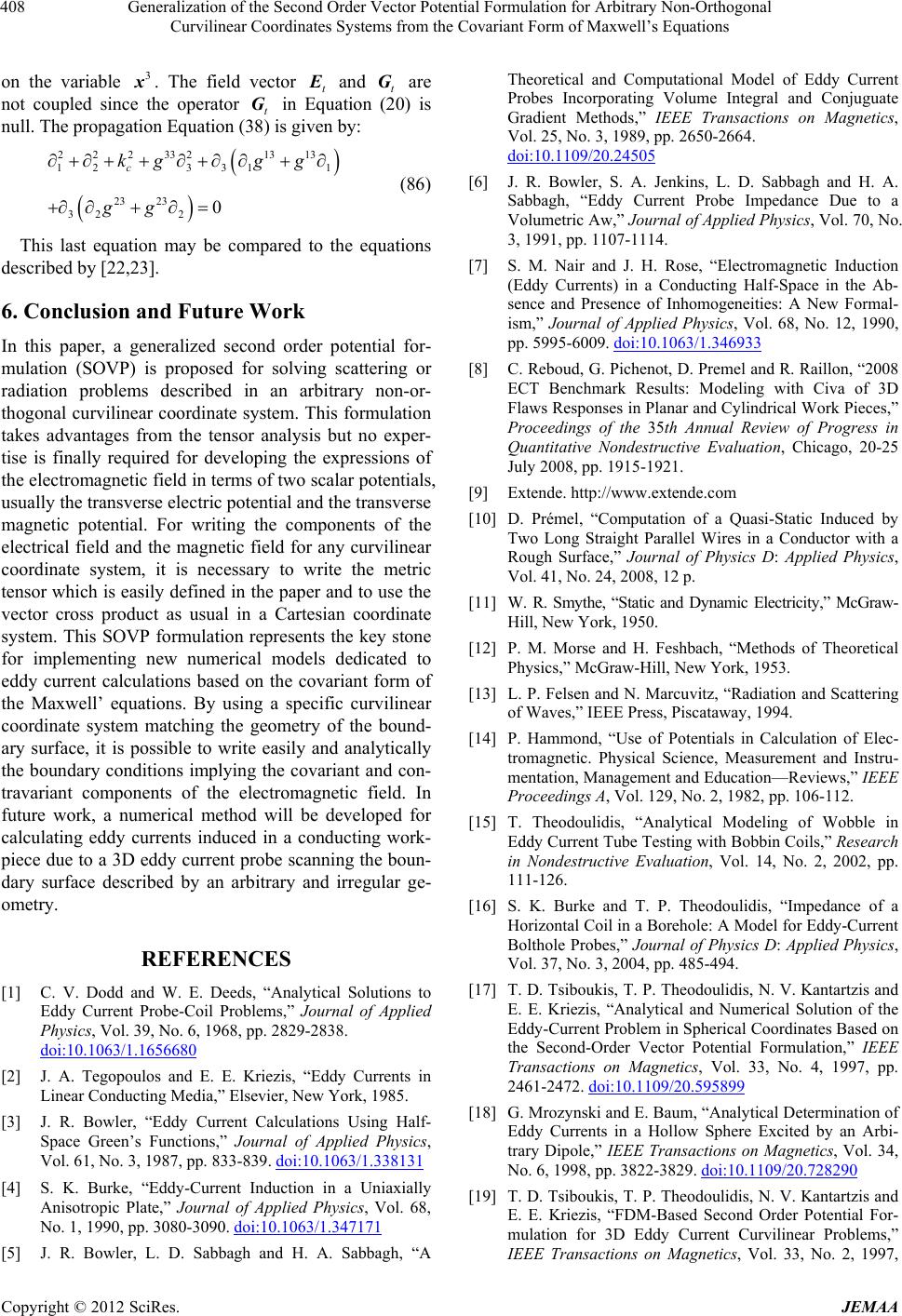
Generalization of the Second Order Vector Potential Formulation for Arbitrary Non-Orthogonal
Curvilinear Coordinates Systems from the Covariant Form of Maxwell’s Equations
408
on the variable . The field vector t
3
x
and t
G are
not coupled since the operator t in Equation (20) is
null. The propagation Equation (38) is given by:
G
22233 21313
12331 1
23 23
322 0
c
kgg g
gg
(86)
This last equation may be compared to the equations
described by [22,23].
6. Conclusion and Future Work
In this paper, a generalized second order potential for-
mulation (SOVP) is proposed for solving scattering or
radiation problems described in an arbitrary non-or-
thogonal curvilinear coordinate system. This formulation
takes advantages from the tensor analysis but no exper-
tise is finally required for developing the expressions of
the electromagnetic field in terms of two scalar potentials,
usually the transverse electric potential and the transverse
magnetic potential. For writing the components of the
electrical field and the magnetic field for any curvilinear
coordinate system, it is necessary to write the metric
tensor which is easily defined in the paper and to use the
vector cross product as usual in a Cartesian coordinate
system. This SOVP formulation represents the key stone
for implementing new numerical models dedicated to
eddy current calculations based on the covariant form of
the Maxwell’ equations. By using a specific curvilinear
coordinate system matching the geometry of the bound-
ary surface, it is possible to write easily and analytically
the boundary conditions implying the covariant and con-
travariant components of the electromagnetic field. In
future work, a numerical method will be developed for
calculating eddy currents induced in a conducting work-
piece due to a 3D eddy current probe scanning the boun-
dary surface described by an arbitrary and irregular ge-
ometry.
REFERENCES
[1] C. V. Dodd and W. E. Deeds, “Analytical Solutions to
Eddy Current Probe-Coil Problems,” Journal of Applied
Physics, Vol. 39, No. 6, 1968, pp. 2829-2838.
doi:10.1063/1.1656680
[2] J. A. Tegopoulos and E. E. Kriezis, “Eddy Currents in
Linear Conducting Media,” Elsevier, New York, 1985.
[3] J. R. Bowler, “Eddy Current Calculations Using Half-
Space Green’s Functions,” Journal of Applied Physics,
Vol. 61, No. 3, 1987, pp. 833-839. doi:10.1063/1.338131
[4] S. K. Burke, “Eddy-Current Induction in a Uniaxially
Anisotropic Plate,” Journal of Applied Physics, Vol. 68,
No. 1, 1990, pp. 3080-3090. doi:10.1063/1.347171
[5] J. R. Bowler, L. D. Sabbagh and H. A. Sabbagh, “A
Theoretical and Computational Model of Eddy Current
Probes Incorporating Volume Integral and Conjuguate
Gradient Methods,” IEEE Transactions on Magnetics,
Vol. 25, No. 3, 1989, pp. 2650-2664.
doi:10.1109/20.24505
[6] J. R. Bowler, S. A. Jenkins, L. D. Sabbagh and H. A.
Sabbagh, “Eddy Current Probe Impedance Due to a
Volumetric Aw,” Journal of Applied Physics, Vol. 70, No.
3, 1991, pp. 1107-1114.
[7] S. M. Nair and J. H. Rose, “Electromagnetic Induction
(Eddy Currents) in a Conducting Half-Space in the Ab-
sence and Presence of Inhomogeneities: A New Formal-
ism,” Journal of Applied Physics, Vol. 68, No. 12, 1990,
pp. 5995-6009. doi:10.1063/1.346933
[8] C. Reboud, G. Pichenot, D. Premel and R. Raillon, “2008
ECT Benchmark Results: Modeling with Civa of 3D
Flaws Responses in Planar and Cylindrical Work Pieces,”
Proceedings of the 35th Annual Review of Progress in
Quantitative Nondestructive Evaluation, Chicago, 20-25
July 2008, pp. 1915-1921.
[9] Extende. http://www.extende.com
[10] D. Prémel, “Computation of a Quasi-Static Induced by
Two Long Straight Parallel Wires in a Conductor with a
Rough Surface,” Journal of Physics D: Applied Physics,
Vol. 41, No. 24, 2008, 12 p.
[11] W. R. Smythe, “Static and Dynamic Electricity,” McGraw-
Hill, New York, 1950.
[12] P. M. Morse and H. Feshbach, “Methods of Theoretical
Physics,” McGraw-Hill, New York, 1953.
[13] L. P. Felsen and N. Marcuvitz, “Radiation and Scattering
of Waves,” IEEE Press, Piscataway, 1994.
[14] P. Hammond, “Use of Potentials in Calculation of Elec-
tromagnetic. Physical Science, Measurement and Instru-
mentation, Management and Education—Reviews,” IEEE
Proceedings A, Vol. 129, No. 2, 1982, pp. 106-112.
[15] T. Theodoulidis, “Analytical Modeling of Wobble in
Eddy Current Tube Testing with Bobbin Coils,” Research
in Nondestructive Evaluation, Vol. 14, No. 2, 2002, pp.
111-126.
[16] S. K. Burke and T. P. Theodoulidis, “Impedance of a
Horizontal Coil in a Borehole: A Model for Eddy-Current
Bolthole Probes,” Journal of Physics D: Applied Physics,
Vol. 37, No. 3, 2004, pp. 485-494.
[17] T. D. Tsiboukis, T. P. Theodoulidis, N. V. Kantartzis and
E. E. Kriezis, “Analytical and Numerical Solution of the
Eddy-Current Problem in Spherical Coordinates Based on
the Second-Order Vector Potential Formulation,” IEEE
Transactions on Magnetics, Vol. 33, No. 4, 1997, pp.
2461-2472. doi:10.1109/20.595899
[18] G. Mrozynski and E. Baum, “Analytical Determination of
Eddy Currents in a Hollow Sphere Excited by an Arbi-
trary Dipole,” IEEE Transactions on Magnetics, Vol. 34,
No. 6, 1998, pp. 3822-3829. doi:10.1109/20.728290
[19] T. D. Tsiboukis, T. P. Theodoulidis, N. V. Kantartzis and
E. E. Kriezis, “FDM-Based Second Order Potential For-
mulation for 3D Eddy Current Curvilinear Problems,”
IEEE Transactions on Magnetics, Vol. 33, No. 2, 1997,
Copyright © 2012 SciRes. JEMAA